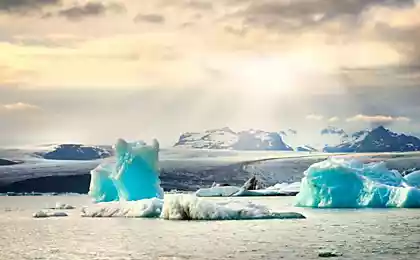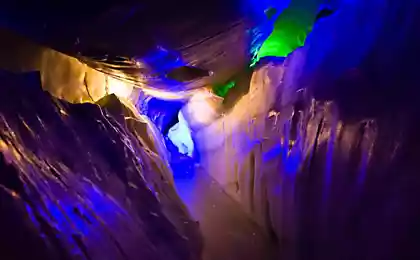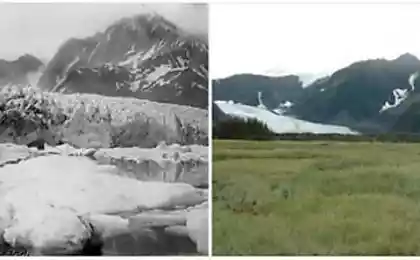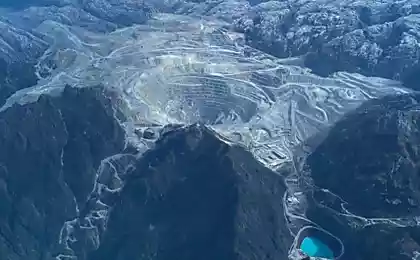496
The melting of mountain glaciers will lead to a shortage of fresh water
Mountain snow and glaciers are the main fresh water source for approximately 1.6 billion inhabitants of our planet. But after 50 years, global warming may destroy these sources, and millions of people will have to look for other opportunities. Although conservation, additional storage tanks and repair of current roads would help mitigate the problem, it is expected that attempts to adapt to the disappearance of the snow caps and glaciers will require new developments in the agricultural and industrial technologies, as well as in lifestyle.

With such a warning made by American scientists after measurements and analysis of computer models related to the impact of global warming on the ecology of the mountains. In conjunction with another study on the flow of rivers in key regions of the world, it has allowed scientists to create a full picture of future freshwater resources in a warming period.Attempts to predict the impact of global warming on water resources is taken for several years.
In the Western United States, some scientists at least five years suggests that, despite the errors of the computer models, the results obtained are sufficiently reliable to regional leaders can develop long-term plans for water management.But the American West is not the only place on Earth where the winter snow is used for irrigation, electricity generation and water systems. A group of scientists from Institute of Oceanography, led by Timothy Barnett, examined other regions, where snow is used as a source at least 50% of the water and did not have the capacity to create a reserve for a year.
The scientists used a "simple and indisputable" principles, he said. "When it gets warmer, the precipitation falls as rain, not snow. And snow caps in the context of global warming will melt faster." This means that in summer and autumn the water will be less.The researchers examined the effect of reducing the snow caps of the Rhine in Europe, the canadian prairies and the Western part of the United States. They talk about the many consequences, from reduction in freight navigation of the Rhine to the vulnerability of agriculture to drought.
As for glaciers, it is "fossil water," says Barnett. "They may melt before the end, when you and I don't think there is a problem. And then it turns out that they're gone".One of the studied regions is the area whose thirst quench glaciers of the Himalayas and the Hindu Kush. These mountains are the third in the world in the amount of ice, after Antarctica and Greenland. The rivers which they feed, provide water to 50-60% of the population.
However, a recent study conducted in China shows that over the 25 years the area of glaciers reduced."Yes, it's reliable," says Christopher Milly, research fellow, Geological society of America. Millie and two of his colleagues conducted a comparative analysis of results derived from 12 climate models to predict annual water flows all over the world.The model showed that by 2050, water flow in the Eastern part of Equatorial Africa, the La Plata basin in South America and in the polar regions of North America and Eurasia will increase by 10-40%. In North Africa, southern Europe, Western North America and the middle East is expected to decline by 10-30%.Impact on the regions along the rivers which will flow more water will be positive, says Millie.
However, previous studies indicate that in some regions, where the volume of water will increase, this increase will be sudden jumps that complicate the creation of reserves, writes Rupor.Info."It is important that we start thinking about it now, says Lara binder, an expert working group on climate change at the University of Washington. – We should not be in a situation when we are trying to keep up with events."
Source: ecowars.tv/

With such a warning made by American scientists after measurements and analysis of computer models related to the impact of global warming on the ecology of the mountains. In conjunction with another study on the flow of rivers in key regions of the world, it has allowed scientists to create a full picture of future freshwater resources in a warming period.Attempts to predict the impact of global warming on water resources is taken for several years.
In the Western United States, some scientists at least five years suggests that, despite the errors of the computer models, the results obtained are sufficiently reliable to regional leaders can develop long-term plans for water management.But the American West is not the only place on Earth where the winter snow is used for irrigation, electricity generation and water systems. A group of scientists from Institute of Oceanography, led by Timothy Barnett, examined other regions, where snow is used as a source at least 50% of the water and did not have the capacity to create a reserve for a year.
The scientists used a "simple and indisputable" principles, he said. "When it gets warmer, the precipitation falls as rain, not snow. And snow caps in the context of global warming will melt faster." This means that in summer and autumn the water will be less.The researchers examined the effect of reducing the snow caps of the Rhine in Europe, the canadian prairies and the Western part of the United States. They talk about the many consequences, from reduction in freight navigation of the Rhine to the vulnerability of agriculture to drought.
As for glaciers, it is "fossil water," says Barnett. "They may melt before the end, when you and I don't think there is a problem. And then it turns out that they're gone".One of the studied regions is the area whose thirst quench glaciers of the Himalayas and the Hindu Kush. These mountains are the third in the world in the amount of ice, after Antarctica and Greenland. The rivers which they feed, provide water to 50-60% of the population.
However, a recent study conducted in China shows that over the 25 years the area of glaciers reduced."Yes, it's reliable," says Christopher Milly, research fellow, Geological society of America. Millie and two of his colleagues conducted a comparative analysis of results derived from 12 climate models to predict annual water flows all over the world.The model showed that by 2050, water flow in the Eastern part of Equatorial Africa, the La Plata basin in South America and in the polar regions of North America and Eurasia will increase by 10-40%. In North Africa, southern Europe, Western North America and the middle East is expected to decline by 10-30%.Impact on the regions along the rivers which will flow more water will be positive, says Millie.
However, previous studies indicate that in some regions, where the volume of water will increase, this increase will be sudden jumps that complicate the creation of reserves, writes Rupor.Info."It is important that we start thinking about it now, says Lara binder, an expert working group on climate change at the University of Washington. – We should not be in a situation when we are trying to keep up with events."
Source: ecowars.tv/






















